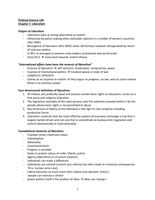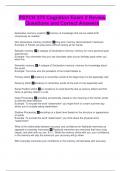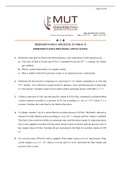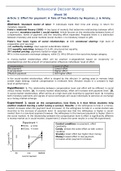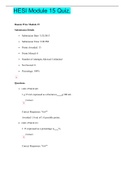Political Science 144
Chapter 7: Liberalism
Origins of Liberalism
- Liberalism seen as strong alternative to realism
- Influenced by policy-making elites and public opinion in a number of western countries
after WW1
- Resurgence of liberalism after WW2 when UN formed, however extinguished by return
of cold war politics
- In 90’s re-emerged as western state leaders proclaimed new world order
- Since 9/11 many back towards realism theory
“international affairs have been the nemesis of liberalism”
- Essence of liberalism self-restraint, moderation, compromise, peace
- Essence of international politics troubled peace or state of war
- COMPLETE OPPOSITE
- Comes as no surprise to realists they argue no progress, no law, and no justice where
there is no common power
Four dimensional definition of liberalism:
1. All citizens are juridically equal and possess certain basic rights to education, access to a
free press and religious toleration
2. The legislative assembly of the state possess only the authority invested within it by the
people whose basic rights is not permitted to abuse
3. Key dimension of liberty of the individual is the right to own property including
productive forces
4. Liberalism contends that the most effective system of economic exchange is one that is
largely market-driven and not one that is subordinate to bureaucratic regulation and
control (domestically or internationally)
Foundational elements of liberalism
- Freedom (most important value)
- Individualism
- Rationality
- Constitutionalism
- Progress is possible
- Seeks to project values of order, liberty, justice
- Agency (liberalism) vs structure (realism)
- Individuals can make a difference
- Individuals are rational (realism also rational but often leads to irrational consequences
ie. nuclear arms race)
- Liberal becomes so much more than realism (can become ‘messy’)
- ‘people can exercise a choice’
- power politics itself is the product of ideas ideas can change !
1
Chapter 7: Liberalism
Origins of Liberalism
- Liberalism seen as strong alternative to realism
- Influenced by policy-making elites and public opinion in a number of western countries
after WW1
- Resurgence of liberalism after WW2 when UN formed, however extinguished by return
of cold war politics
- In 90’s re-emerged as western state leaders proclaimed new world order
- Since 9/11 many back towards realism theory
“international affairs have been the nemesis of liberalism”
- Essence of liberalism self-restraint, moderation, compromise, peace
- Essence of international politics troubled peace or state of war
- COMPLETE OPPOSITE
- Comes as no surprise to realists they argue no progress, no law, and no justice where
there is no common power
Four dimensional definition of liberalism:
1. All citizens are juridically equal and possess certain basic rights to education, access to a
free press and religious toleration
2. The legislative assembly of the state possess only the authority invested within it by the
people whose basic rights is not permitted to abuse
3. Key dimension of liberty of the individual is the right to own property including
productive forces
4. Liberalism contends that the most effective system of economic exchange is one that is
largely market-driven and not one that is subordinate to bureaucratic regulation and
control (domestically or internationally)
Foundational elements of liberalism
- Freedom (most important value)
- Individualism
- Rationality
- Constitutionalism
- Progress is possible
- Seeks to project values of order, liberty, justice
- Agency (liberalism) vs structure (realism)
- Individuals can make a difference
- Individuals are rational (realism also rational but often leads to irrational consequences
ie. nuclear arms race)
- Liberal becomes so much more than realism (can become ‘messy’)
- ‘people can exercise a choice’
- power politics itself is the product of ideas ideas can change !
1


